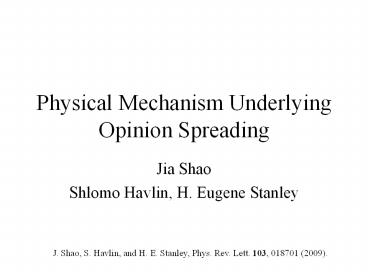Physical Mechanism Underlying Opinion Spreading - PowerPoint PPT Presentation
Title:
Physical Mechanism Underlying Opinion Spreading
Description:
This phase transition can be mapped to a physical process of water spreading in ... US presidential elections Community support is essential for a small population ... – PowerPoint PPT presentation
Number of Views:49
Avg rating:3.0/5.0
Title: Physical Mechanism Underlying Opinion Spreading
1
Physical Mechanism Underlying Opinion Spreading
- Jia Shao
- Shlomo Havlin, H. Eugene Stanley
J. Shao, S. Havlin, and H. E. Stanley, Phys. Rev.
Lett. 103, 018701 (2009).
2
Questions
- How can we understand, and model the coexistence
of two mutually exclusive opinions? - Is there a simple physical mechanism underlying
the spread of mutually exclusive opinions?
3
Motivation
- Coexistence of two (or more) mutual exclusive
opinions are commonly seen social phenomena. - Example US presidential elections
- Community support is essential for a small
population to hold their belief. - Example the Amish people
- Existing opinion models fail
- to demonstrate both.
4
What do we do?
- We propose a new opinion model based on local
configuration of opinions (community support),
which shows the coexistence of two opinions. - If we increase the concentration of minority
opinion, people holding the minority opinion
show a phase transition from small isolated
clusters to large spanning clusters. - This phase transition can be mapped to a physical
process of water spreading in the layer of oil.
5
Evolution of mutually exclusive opinions
23
Time 0
34
Time 1
stable state (no one in local minority opinion)
Time 2
6
A. Opinion spread for initially
23
stable state 14
7
B. Opinion spread for initially
11
stable state 11
8
Phase Transition on square lattice
Phase 1
Phase 2
B
largest
size of the second largest cluster
100
A
critical initial fraction fc0.5
9
2 classes of network differ in degree k
distribution
Poisson distribution
Power-law distribution
(ii) scale-free
(i) Erdos-Rényi
µ
µ
Log P(k)
µ
Log k
10
Phase Transition for both classes of network
fc0.46
fc0.30
(b) scale-free
(a) Erdos-Rényi
µ
Q1 At fc , what is the distribution of cluster
size s? Q2 What is the average distance r
between nodes belonging to the same cluster?
11
Invasion Percolation
Example Inject water into layer containing oil
- Invasion percolation describes the evolution of
the front between two immiscible liquids in a
random medium when one liquid is displaced by
injection of the other. - Trapped region will
- not be invaded.
A Injection Point
D. Wilkinson and J. F. Willemsen, J. Phys.
A 16, 3365 (1983).
12
Invasion Percolation
Trapped Region of size s P(s) s-1.89
S
Fractal dimension 1.84 s r1.84
S. Schwarzer et al., Phys. Rev. E. 59, 3262
(1999).
13
Clusters formed by minority opinion at fc
r
Cumulative distribution function
P(sgts) s-0.89
r/s(1/1.84)
Const.
s r1.84
PDF P(s) s-1.89
Conclusion Phase transition of opinion model
belongs to the same universality class of
invasion percolation.
14
Summary
- Proposed an opinion model showing coexistence of
two opinions. - The opinion model shows phase transition
- at fc.
- Linked the opinion model with an
oil-field-inspired physics problem, invasion
percolation.
15
Thank you!































